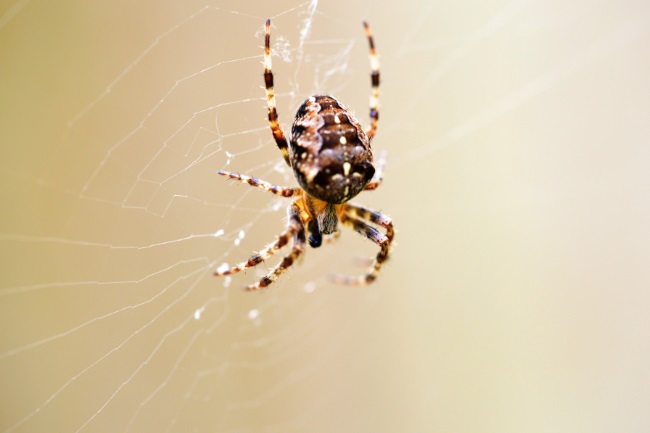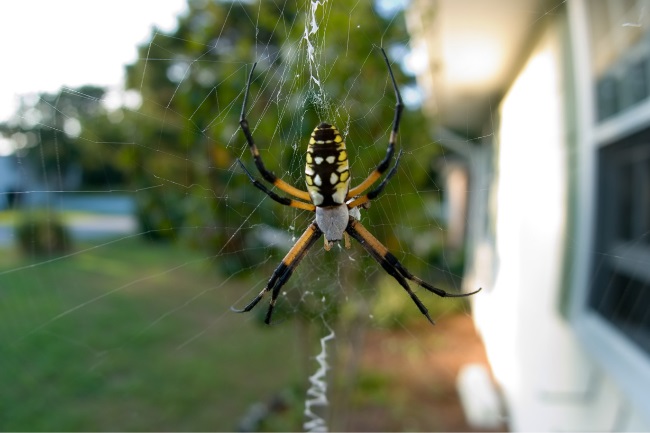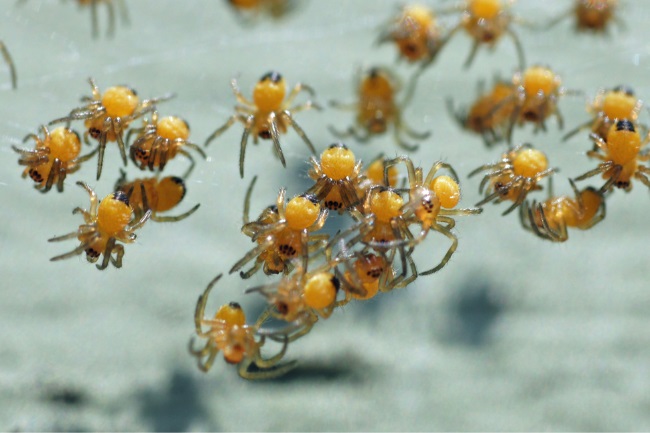The Eurasian garden spider (Araneus diadematus) is between 5mm (0.20in) and 20mm (0.79in) in size, with the male being slightly smaller than the female. They grow into this adult size over their one to two-year lifespan.
Contents
How big is a spider?

Spiders worldwide come in all shapes and sizes, with the largest being the giant huntsman at one foot in length and the smallest being the male Patu digua at 0.3mm (0.01in). These different sizes exploit different niches, adapted to their environments and their prey. Tiny goldenrod crab spiders hide in flower heads, legs stretched out, in order to catch visiting pollinators.
| Spider Gender | Average Length (inches) |
|---|---|
| Female Garden Spider | 0.5 – 1.5 |
| Male Garden Spider | 0.2 – 0.5 |
Much larger tarantulas, by comparison, hid in burrows, ready to ambush whatever creatures are unlucky enough to be passing by the entrance. Yet, before you start worrying about human-sized spiders abseiling down above you, it’s worth remembering that all invertebrates are limited in size by their exoskeleton. Too large, and the weight of this thick outer layer would crush them, a little good news for the arachnophobic amongst us.
Also read: Are Garden Spiders Dangerous? (Arachnophobia Explained)
Why be as big as a garden spider?
So given that a spider can be any size between that of a grain of sand, up to a foot long, why be the size of a garden spider? The garden spider’s size has evolved based mainly on two forces; the creatures they eat and the creatures that eat them. With their large open webs, garden spiders are able to catch relatively big prey, such as wasps and butterflies. If they were much smaller than their current size, they would struggle with such large prey, both in terms of manhandling it and for their venom to be effective.

Much larger prey, such as birds, or even large beetles, wouldn’t be able to be caught in their webs. This means there is a limit to how big it benefits them to become whilst using their current method of hunting. Additionally, in order to remain hidden from the many predators that might enjoy a tasty spider snack, it benefits these arachnids not to be too big. So this is how the garden spider has come to be what it is today, not too small to handle big insects and not too big to be easily spotted and eaten.
Are males and females the same size?
As with many species of spiders, the male and female garden spiders are very different sizes, with the female being the larger of the two, between 6mm – 20mm (0.24-79in), whilst the male is only between 5mm – 13mm (0.20-0.51in).
The female is smaller than the female in many animals due to the additional strain her body has to undergo from the production of young. Once mating has occurred, the male’s job is done, whereas the female must produce and carry the eggs, before finding a suitable place for them to hatch, encasing them in silk and standing guard over them. All that extra work certainly requires a little more muscle.
| Characteristic | Female Garden Spider | Male Garden Spider |
|---|---|---|
| Size | Generally larger | Generally smaller |
| Body Shape | Fuller abdomen | Slender abdomen |
| Coloration | Often more vibrant | May appear duller |
| Leg Length | Generally longer legs | Generally shorter legs |
| Spinnerets | Larger spinnerets | Smaller spinnerets |
| Palps | Absent or small | Prominent and elongated palps |
Stages of growing

Of course, the garden spider doesn’t wander into the world fully formed and ready to go. Instead, it starts out as a tiny egg, carefully secured with a delicate egg sac, woven out of silk by its mother. Once the egg hatches, a tiny spiderling emerges, along with its many siblings. This spiderling now needs to fatten itself up as quickly as possible in order to grow to its proper adult size.
Like all invertebrates, growing is a complicated process for our little garden spiders. To get bigger, they need to break out of and shrug off their own skin. Each growth stage is known as an instar. They can change significantly throughout these stages, with their first instar being bright yellow with a black marking and their final form having a speckled brown colouration.
Garden spiders go through several instars as they grow. Each time they will leave behind a perfect replica of themselves, a hollowed-out form that looks like it’s frozen in time. You’ll probably find some of these abandoned exoskeletons as you’ve been clearing up cobwebs in your house, thinking for a moment you’ve captured a living spider, only to see it’s actually just a husk.
Little spider, big personality
There are many large and colourful spiders in the world, which are more attention-grabbing than the garden spider. When we tend to think of spiders, we often picture tarantulas or other large exotic species. Yet, the garden spider is our most neighbourly spider for many of us, the one we see most often in our parks, woodland walks and gardens.
Most of the year, they are so small and well hidden that we won’t even spot them. Yet, when we do, the garden spider is a fascinating and wonderful species, punching well above its weight in taking care of pests for us and festooning our world in intricate and beautiful webs.

